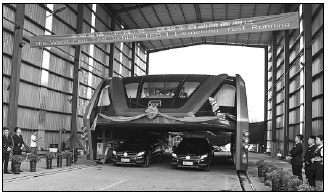Elevated bus currently just for tourism Jin Dan
|
A test run of public bus TEB1 is held in Qinhuangdao, Hebei province, on Tuesday. Luo Xiaoguang / Xinhua |
The futuristic public bus TEB-1 is just for tourism rather than for transportation, local authorities said on Friday in Qinhuangdao, Hebei province, where the elevated bus took its first road test on Tuesday.
The concept of elevating the carriage above the road to allow vehicles to pass underneath it drew much attention when it was first unveiled during the Beijing International High-tech Expo in May. The 22-meter-long TEB-1, which was tested on Tuesday, is a prototype of a four-compartment bus.
As it moved one step closer to reality, its feasibility was seriously questioned online, and several media reports even claimed that it was nothing but a gimmick to sell fundraising products.
Amid the whirlwind of controversy and heated discussion, Zhai Wen, head of the transport division of the development and reform commission of Qinhuangdao, told China National Radio that the road test of TEB-1 was just for tourism.
The test was approved on a 300-meter part of a dead-end highway, Zhai said.
Dong Xin, who experienced the test, expressed his disappointment to China National Radio, saying that TEB-1 only ran about 50 meters at a slow speed and they felt hot in its enclosed carriage as the air conditioning system was not on.
The full version of the bus will reportedly be 60 meters long, 7.8 meters wide and 4.8 meters high, capable of carrying 1,200 to 1,400 passengers and run at an average speed of 40 km/h, according to TEB Tech's website. It is advertised as a solution to traffic congestion, as its passenger compartment rises far above other vehicles on the road, allowing cars to pass underneath.
However, transport experts expressed doubts, as the huge vehicle would need to move slowly in case it needs to apply its emergency brakes. Other limitations include current traffic rules and facilities.
To make TEB a reality, pedestrian bridges and overpasses would have to be removed or rebuilt, while overhead wires, lamp posts, road signs and traffic cameras all would have to be moved higher.
Vehicles underneath would find it hard to change directions or change lanes.
As TEB is not transparent, drivers beneath it may not see road signs clearly, and height limitations underneath the TEB may cause problems for drivers, experts said.
Jin Dan contributed to this story.



















